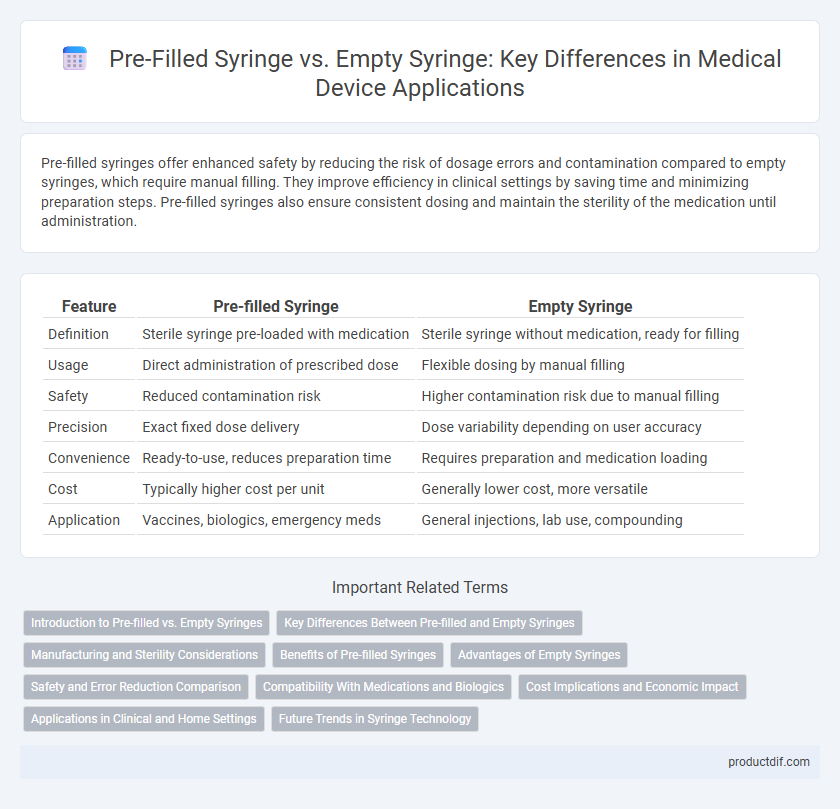Pre-filled syringes offer enhanced safety by reducing the risk of dosage errors and contamination compared to empty syringes, which require manual filling. They improve efficiency in clinical settings by saving time and minimizing preparation steps. Pre-filled syringes also ensure consistent dosing and maintain the sterility of the medication until administration.
Table of Comparison
| Feature | Pre-filled Syringe | Empty Syringe |
|---|---|---|
| Definition | Sterile syringe pre-loaded with medication | Sterile syringe without medication, ready for filling |
| Usage | Direct administration of prescribed dose | Flexible dosing by manual filling |
| Safety | Reduced contamination risk | Higher contamination risk due to manual filling |
| Precision | Exact fixed dose delivery | Dose variability depending on user accuracy |
| Convenience | Ready-to-use, reduces preparation time | Requires preparation and medication loading |
| Cost | Typically higher cost per unit | Generally lower cost, more versatile |
| Application | Vaccines, biologics, emergency meds | General injections, lab use, compounding |
Introduction to Pre-filled vs. Empty Syringes
Pre-filled syringes offer precise dosing, enhanced sterility, and reduced preparation time compared to empty syringes, which require manual filling before use. Medical professionals often prefer pre-filled syringes for improved patient safety and minimized risk of contamination. The choice between pre-filled and empty syringes depends on application needs, storage requirements, and cost considerations in clinical settings.
Key Differences Between Pre-filled and Empty Syringes
Pre-filled syringes offer precise dosage accuracy and reduced contamination risk compared to empty syringes, which require manual filling and pose higher chances of dosing errors and infection. Pre-filled syringes enhance patient safety and streamline clinical workflows by minimizing preparation time, while empty syringes provide flexibility for various drug formulations and volumes. The choice between pre-filled and empty syringes depends on factors such as medication stability, administration convenience, and cost-effectiveness in medical device applications.
Manufacturing and Sterility Considerations
Pre-filled syringes reduce contamination risks by minimizing manual filling steps during manufacturing, ensuring enhanced sterility and consistent dosing accuracy. Empty syringes allow flexibility in drug formulation but require aseptic filling processes under strict sterile conditions to maintain product integrity. Manufacturing pre-filled syringes demands integration of drug and device production lines with validated sterilization methods such as gamma irradiation or ethylene oxide.
Benefits of Pre-filled Syringes
Pre-filled syringes significantly reduce the risk of dosage errors and contamination by delivering a precise, sterile dose ready for immediate use. They enhance patient safety and convenience by eliminating the need for manual filling, which also decreases preparation time and medical waste. This efficient delivery system supports better medication adherence and streamlines clinical workflows in healthcare settings.
Advantages of Empty Syringes
Empty syringes offer greater flexibility for healthcare providers, allowing precise customization of medication type and dosage at the point of care. Their universal compatibility with various drugs and needles reduces inventory complexity and lowers storage costs in medical facilities. Additionally, empty syringes support strict aseptic techniques, minimizing contamination risks during preparation and administration.
Safety and Error Reduction Comparison
Pre-filled syringes significantly reduce the risk of dosage errors and contamination compared to empty syringes by eliminating manual drug drawing and ensuring precise, pre-measured doses. Their sealed design minimizes exposure to pathogens, enhancing patient safety during administration. Conversely, empty syringes require additional handling steps that increase the likelihood of needle-stick injuries and medication mishaps.
Compatibility With Medications and Biologics
Pre-filled syringes provide enhanced compatibility with medications and biologics by reducing the risk of contamination and ensuring precise dosing, which is critical for sensitive biologic formulations. Empty syringes require additional steps for filling, potentially exposing medications to environmental factors that can compromise stability and efficacy. Compatibility with specific drug formulations, including monoclonal antibodies and vaccines, is optimized in pre-filled syringes through advanced materials and barrier technologies that maintain drug integrity over time.
Cost Implications and Economic Impact
Pre-filled syringes typically reduce overall healthcare costs by minimizing medication waste, lowering contamination risks, and decreasing administration time compared to empty syringes requiring manual filling. Although pre-filled syringes have a higher upfront price, their efficiency contributes to cost savings in hospital workflows and patient safety outcomes. Economic impact analyses show that adopting pre-filled syringes can lead to reduced labor expenses and fewer adverse drug events, promoting long-term financial benefits for healthcare providers.
Applications in Clinical and Home Settings
Pre-filled syringes offer precise dosing and reduced contamination risk, making them ideal for vaccine administration, insulin delivery, and emergency medication in both clinical and home settings. Empty syringes provide greater flexibility for custom medication preparation and are commonly used in hospitals and laboratories for tailored treatments or research purposes. The choice between pre-filled and empty syringes depends on the need for convenience, accuracy, and specific clinical application requirements.
Future Trends in Syringe Technology
Future trends in syringe technology emphasize the advancement of pre-filled syringes due to their enhanced safety, accuracy, and convenience in medication delivery, reducing contamination risks compared to empty syringes. Innovations include smart syringes with integrated sensors for dose verification and connectivity to digital health platforms, improving patient adherence and data tracking. Sustainable materials and auto-disable features are also being developed to address environmental concerns and prevent needle reuse in medical settings.
Pre-filled syringe vs Empty syringe Infographic

 productdif.com
productdif.com